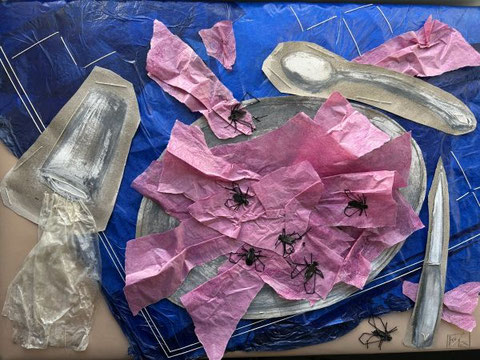By way of an announcement to a coming exhibition, I have the opportunity to present a typical example of my work as part of a wall display for schools, carrying the theme „The Brave Little Tailor “. I have illustrated a scene from the tale with a collage. The longer I worked on the picture – sorting pieces of paper, laying them out, fastening them with needle and thread - the more I began wondering about the background to the story. Somehow this fairy tale is different: it is brittle, it is difficult to identify with the hero and his ambitions, the other characters are not any more likeable, I feel no empathy for the other people depicted in the story? Why does it fail to appeal, to evoke fear and hope?
The action is easy to summarize. A tailor swats and kills seven flies that have settled on his food while he finishes his work. He is surprised by his own action, which he considers to be a heroic deed. He decides he must let the world know about it and sets off. What drives this little man – his size is mentioned repeatedly – to shut up shop, perhaps for ever, and to start an uncertain journey?
Before he turns his back on his home, he sews a belt, embroidered with the words „seven in one fell swoop “, which he wears it for all to see. He deceives everyone into believing that the seven are people he has killed. The accessory also seems to serve as an amulet helping him to face fearlessly the dangers he meets on his wanderings.
The plot is typical of fairy tales: by virtue of his character a person of lowly origin is able to move up the social ladder attaining noble status. Physical strength and the disadvantages of social class are compensated by bravery and cunning. After mastering seven tasks with apparent ease (seven is a magic number in fairy tales and the Bible), he becomes king and receives the king’s daughter in marriage.
The simple narrative style leaves many questions unanswered. This is the case in all versions of the tale; the details vary only slightly. In the Grimm brothers’ text, we read that the tailor wants to escape the narrow confines of his workshop. But does this explain the burst fury that takes hold of him when he sees the flies and the brute energy with which he kills them? Tailoring is associated with skill and neatness coupled with a patient and calm disposition. Why does the little tailor suddenly decide to quit his livelihood? Was it possibly less sudden, were the flies a catalyst? He is obviously keen for adventure and out to make an impression. I eliminate self-discovery, which is the prime motivation in picaresque novels, he is neither hesitant nor doubt-ridden. His character does not develop or mature. On the contrary, he plunges into every peril in dare-devil manner, with no harm to himself and, remarkably, without using physical force. His spontaneous outburst of violence is aimed at flies, tiny creatures which he finds repelling but that present no threat to him, in contrast to the immediate very dangers posed by rogues and giants.
To conclude: this man is not a likeable person, nothing endears him to the reader or to the other characters. At first, the king offers to make him a nobleman and to give him the hand of his daughter in marriage, on condition he accomplishes an important task, which he does, of course. But despite his promise the king has second thoughts and assigns the tailor further tasks to postpone the final rise to regal status. In the end he reluctantly proclaims him king. Equally, the princess, it seems, is not too enamoured by her new husband – whereby women were not generally asked for their preferences in arranged marriages – but the cup overflows when she discovers he is only a craftsman. She and her father set the tailor a trap, from which he escapes, of course, but this is not the happy end we expect in fairy tales. Our hero is not a captivator of hearts, there is no mention of good fortune and affection, let alone love. The tale leaves me with the impression that both the king and his daughter grind their teeth and grimly resign themselves to the situation.
Do children like this fairy tale? Is it a good bedtime story? Would give me a different perspective on this little man and his adventures?

